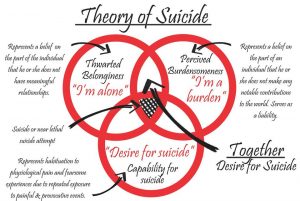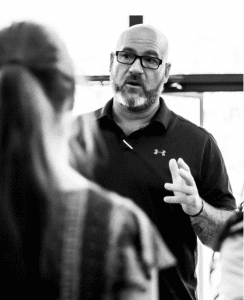My name is Jeff Yalden.

Many know me as a youth motivational speaker. For 26 years now, this has been my passion.
Since 1992, I have presented to more than 4000 live audiences at schools, colleges and mental health organizations in this country and around the world – and it is an absolute joy to inspire young people – to see their faces light up when they experience an A-HA! moment – and to help guide them on their lives’ journeys.
That being said, I am also a teen suicide prevention and crisis intervention expert.
This is the tough part.
I have grieved with so many families over the years, and with each devastating loss, the heartache and pain – the very idea of trying to be a source of hope and comfort only compounds the sobering realization that the teen suicide epidemic continues to grow.
Mental health is not just a family issue anymore. I think it’s quickly becoming an economic issue that could become the biggest public health crisis of our time.
The biggest problem I have is that schools today are afraid to talk about suicide. I get it. I understand, but we need to reach a point where we get comfortable about being uncomfortable.
But I’m here today to talk about the WHY behind the teen suicide epidemic.
Back in 2005, a professor at Florida State University, Dr. Thomas Joiner, published his theory on suicide – specifically his “Interpersonal Theory of Suicidal Behavior.”
His theory points to two factors that contribute to suicide:
“I am alone,” and “I am a burden.”
And what this means is…
The “I am alone” – which is, as Joiner says, a “thwarted belongingness” – represents a belief on the part of the individual that she or she does not have any meaningful relationships.
“I am a burden” – which is a “perceived burdensomeness” represents a belief on the part of the individual that he or she does not make any notable contributions to the world. They think that they serve as a liability.
So, when you have the “I am alone” and the “I am a burden,” – that kind of creates the DESIRE FOR SUICIDE – which becomes the capability for suicide over a period of time, and Joiner here again – the “capability for suicide is acquired largely through repeated exposure to painful or fearsome experiences. This results in habituation and, in turn, a higher tolerance for pain and a sense of fearlessness in the face of death.”
Habituation is a fancy term for getting used to something.
I became a fan of Dr. Joiner as I got into researching the topic of suicide – but more specifically Teen Suicide.
When you get to the “I am alone” part, you are like, WHY? Why do teens feel alone today?
Why do teens feel like they are a burden – and that they serve as a liability?
And then – why do they just feel so hopeless?
In all my work in the trenches with teens and talking to teens, I have come to believe that even the most troubled teens don’t want to die. I think it’s that they can’t find a solution to their problems – that the solution is so far out there that they can’t solve it and move forward.
Remember: Today’s teens live in the here and the now.
Teens don’t know what they don’t know – and there is no way for them to know what the future can hold.
And today’s teenagers – the Generation Z kids born from the mid-1990s to the early 2000s – are the first teenagers to not know what’s it like to grow up without a smartphone.
Let’s look at this:
As much as we say suicide is because of this or suicide is because of that – it’s bullying, it’s cyber-bullying, it’s this, it’s that – suicide is never the result of one thing – but one thing can certainly be the straw that breaks the camel’s back.

The reality is that 90 percent of teen suicides go back to mental illness – and if you think about today’s teens – two of the biggest challenges that we have are coping skills and problem-solving skills.
In my work, I find that that teenagers have a really tough time communicating – sharing their feelings – trusting in the circle of adults in their life – and so – when you ask me, “Hey Jeff – what is the greatest thing that you can give teenagers today,” I don’t even hesitate. I say, “self-esteem.”
But where does self-esteem come from?
Self-esteem comes from being challenged and overcoming those challenges.
I think self-esteem comes from social interaction. It comes from involvement with your friends and family – relationships. Self-esteem comes from being outside – coping through life – problem-solving through your challenges. Self-esteem is something we build every day as a result of being more active.
I think three things are really important to a teen’s mental health:
1) SLEEP
2) NUTRITION – Today’s teenagers are consuming over 200 grams more sugar a day than they should be consuming in a 24-hour period – and sugar is directly related to depression.
3) MORE ACTIVITY/MORE SOCIAL ENGAGEMENT
These three things play a significant role in one’s mental health.
Some say that Generation Z – the young people born after 1995 – are more likely to experience mental health issues than their Millennial predecessors.
Today’s adolescents are at even greater risk of mental health problems – and so you keep asking the questions “Why are today’s teens worse off than the Millennials?”
And then, “Why are today’s adolescents in worse shape than Generation Z?”
Why…
Let’s look at 2012. That is the time when smartphones surged into the lives of our teens – and with that, in 2012 – over 50 percent of our teens had smartphones, so they started to get more invested in social media, YouTube, the Internet, group texting –
In 2015 – they say over 73 percent of our teens had access to a smartphone. Today – 2018 – over 90 percent of our kids have access to a smartphone.
From 2012-2018 – in those six years, the smartphone became something that was very much more common in the lives of our teens. Not just more common, but more widely-used for longer periods of time.
From 2010-2015, surveys said that 35 percent of teens felt alone and a burden.
Feeling alone and a burden, going back to Thomas Joiner’s theory from 2005 – well, those are symptoms of suicide – and they are symptoms of suicide today.
They even said that suicide surged 23 percent – and teen suicide surged 31 percent – and that’s where we are at. These are alarming numbers causing great concern – and we are asking why.
Let’s not just jump to the conclusion that, “Whoa – Jeff is blaming this on smartphones.”
Hold on. I just want to continue asking why. Why is this?
Moving forward – 2012-2018 – that’s six years. More teens were depressed. Greater anxiety. Trouble communicating. Withdrawal. Social isolation – hopelessness – and seeing suicide as the solution to their problems.
Again – why?
All signs point to the sudden ascendance of the smartphone.
As more and more teens gained access to a smartphone, more and more teens were feeling depressed – and suicide kept increasing in great numbers.
It’s important to note here that these same surveys say that from 2010-2015 – the time doing homework barely budged.
Why is this important?
It’s important because it rules out academic pressure as the cause of teen suicide.
So – here’s my theory: Smartphone? If you are on your smartphone four to five hours a day or more, you are 70 percent more likely to have mental health issues. Mental health professionals say that one to two hours a day is the safe zone.
Going by these numbers – I think it’s pretty safe to say that time spent online affects a teen’s overall mental health. Right. OK.
Now – could it be that instead of time online causing depression – maybe depression causes more time online, one might ask.
And so – these studies show that this is unlikely.
My theory: Depression might cause people to spend more time online – but why did depression increase so much after 2012?
More teens became depressed for an unknown reason, and then started buying smartphones, which doesn’t seem too logical.
WHAT’S MISSING
You might say that online time doesn’t affect mental health directly – but it still adversely affects mental health in indirect ways – especially if time online interrupts time for other activities. That’s that social engagement – that’s the other activities with friends and family – less smartphones, social media – more time problem-solving, coping, and one-on-one communication.

Again – going back to self-esteem – it’s safe to say that a teen spending time online interrupts time for activities where they could be building their self-esteem – (what I just mentioned: coping skills, problem-solving, communication) – life skills that are essential to their growth as a young adult.
I hope you are following me here.
Teens spend much less time today interacting with friends and family. Without interaction, our moods start to suffer, and depression follows.
Going back to Dr. Joiner – “I am alone – I am a burden.” Those two things lead to sadness. They lead to depression – and the “I am alone – I am a burden” – isolation is also a big factor in suicide ideation – better known as suicidal thoughts.
Let’s look at the amount of time being alone – the amount of time where you feel you are a burden. That brings the desire for suicide – Dr. Joiner’s theory is making sense – more so today – and the capability for suicide grows out of repeated exposure to painful or fearsome experiences
Now – this is starting to make a lot more sense when we look at time online – teens are more likely to be depressed, while making friends and engaging socially and in-person builds their self-esteem.
In 2012, this is what started to happen: Online versus in-person social engagement. Online harms mental health. In-person social engagement benefits mental health.
Remember: 90 percent of suicides. At the core, at the foundation are mental health issues.
I already mentioned that proper sleep and nutrition are a huge benefit to the mental well-being of our young people. They also need to get more involved. This is good for their self-esteem.
Is this research definitive enough? Maybe not. Is it too soon to recommend less screen time? The solution seems to be clear:
If less screen time can help lessen your child’s chances of falling into depression, then the danger of doing nothing can be high. Think about the possible consequences. If we do nothing, then we’re taking a huge risk.
A couple more things before I wrap this up:
Going back to Dr. Joiner’s theory:
“I am alone” is like, “I don’t have meaningful relationships.
“I am a burden.” This is about expectations.
Today’s teens have greater stress. They have the expectations that might not be realistic. They have the fear of not knowing who they are or what they want to do. That’s the “I am a burden.” And the desire for suicide – that’s the pain lasting and building up.
Also – the Dopamine effect from the social media, the Internet and YouTube – it’s like – “I want more, I want more, I want more…”

When you are spending four, five hours a day on your smartphone, the Dopamine effect is more and more and more – versus one-to-two-hours – you have less of the “I want more, I want more.”
So what does all of this lead to?
Our teens are on 24/7 – 365. This is leading to depression, isolation – a feeling that they are not worthy. They want to be validated with “likes” on social media – and social isolation is arguably the strongest and most reliable predictor of suicidal thoughts.
Social isolation leads to loneliness, social withdrawal, living alone with little social support – living in non-intact families. All of this really isn’t helping.
I think it comes down to vigilant parenting, less time online, more social and emotional learning – mindfulness practice – meditation – reducing the stigma of mental health, and letting people know that it is OK to ask for help.
To wrap this up:
Self-esteem: Again, social interaction, sleep, health, exercise, nutrition, activity.
Self-esteem: Involvement, communication, coping skills, problem-solving skills.
Self-esteem: You’re not afraid to ask for help.
Social Isolation: “I am alone. I am a burden.”
When our young people are interacting, they are learning. They’ve got friends. They are figuring themselves out – their identities – they are growing – they have trust – companionship – problem-solving and coping skills – laughter and better communication.
A couple of things, lastly –
Smartphone. Addiction. Isolation. Sadness. Loneliness. Lack of growth, The Dopamine effect. Diminished life skills.
It makes sense that Joiner’s “I am alone” / “I am a burden” is a problem. You see where social media is really adding to that. And then the desire for suicide that emerges from suicidal thoughts stemming from repeated exposure to painful or fear-inducing experiences that these kids go through.
Again – I don’t think students want to die. I think they live in the here and the now – and so they feel like they can never reach solutions to their problems and move on with their lives.
And with the here and the now – everything is just so readily available to them. I mean, you text somebody and you get an immediate response. You pick up your smartphone and someone is automatically there. You go to the bank – and an ATM spits out cash.
I think the biggest problems with our youth today are the lack of coping skills and problem-solving skills.
If we could focus more on social and emotional learning in our schools, I think we would do an awesome job of getting our kids to spend less time on their smartphones and more time interacting – I think that would make a huge life-changing difference.
For more information about Jeff Yalden, go HERE.
Find out about Jeff’s new nonprofit, THE JEFF YALDEN FOUNDATION
To book Jeff now, call (800) 948-9289

